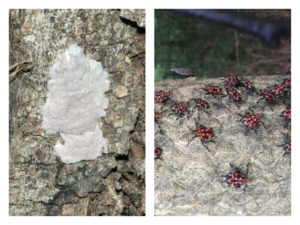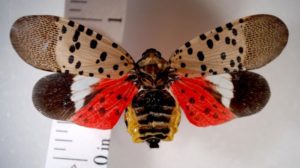Scrape Those Lanternflies Away
March 23rd, 2021
Many of you no doubt noticed that new bug in town late last winter – the spotted lanternfly.

These are various stages of spotted lanternfly egg masses.
(Credit: Heather Leach/Penn State University)
This rather large (pinky-sized) flying insect with the spotted grayish-tan wings (red underneath) has now made its way from its initial 2014 invading point of Berks County to throughout the Harrisburg area.
Lanternfly adults have a 70-plant appetite (especially grapes and maple, walnut, birch, beech, cherry, and willow trees), making it a threat to a lot of our landscape plants if/when their numbers balloon.
Although lanternflies are currently in their egg stage, this is actually the best time of year to deal with this latest imported pest.
Lanternfly egg masses look like a gray smear of mud with a waxy covering. They’re typically seen clinging on tree trunks, firewood, stones, outdoor furniture, or for that matter, any solid, flat, outdoor surface.

A lanternfly egg mass on a tree trunk, left, and what newly hatched lanternfly nymphs look like.
(Credit: Penn State Extension)
By smashing or otherwise getting rid of the masses, you can eliminate anywhere from 30 to 50 new lanternflies per mass.
Penn State Extension recommends scraping the egg masses into jars or plastic bags with a small amount of alcohol or hand sanitizer in order to kill the eggs. Just scraping them off and letting the masses drop to the ground won’t do the trick.
See a Penn State Extension video on how to scrape spotted lanternfly egg masses
Pay special attention if you saw spotted lanternfly adults in or near your yard late last summer and early fall.
Adults are active from mid-summer into early fall and are especially distinctive when you can see their lower pair of spotted red wings when the bug is fully “winged out.”

What a fully “winged out” lanternfly looks like.
(Credit: Holly Raguza, Pa. Department of Agriculture)
Adults pierce trunks, branches and vines, causing a mix of sap and “honeydew” (bug poop) that draws other insects and grows a potentially deadly sooty-mold fungus.
One other thing you can do now is get rid of any trees of Heaven on your property. Those are vigorous invaders anyway that are a favorite host plant for lanternfly egg-laying.
The second line of defense after egg-scraping is “banding” trees to capture newly hatched larvae.
This involves wrapping three-inch-wide bands of sticky flypaper (available at hardware and farm-supply stores or online) around trees about four feet from the ground.
The paper captures the young lanternflies as they attempt to climb upwards in search of a leafy snack.
The best time for banding is between late April through June.
Penn State Extension recommends adding an outer band of chicken wire or screening a few inches out from the bands – ideally covered with cheesecloth or garden fabric – to keep birds, butterflies, and beneficial flying insects from getting caught.
See Penn State Extension’s fact sheet on trapping lanternflies
If you’d rather not get into sticky flypaper, you can buy or make your own “circle trap” that funnels climbing lanternfly nymphs into a bag or plastic container attached to a tree.
Penn State Extension has a web page that gives step-by-step instructions with photos on how to make a lanternfly circle trap.
See Penn State Extension’s web page for more on spotted lanternflies







